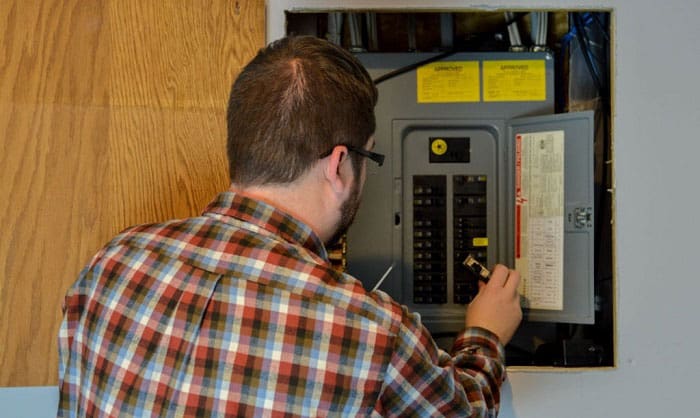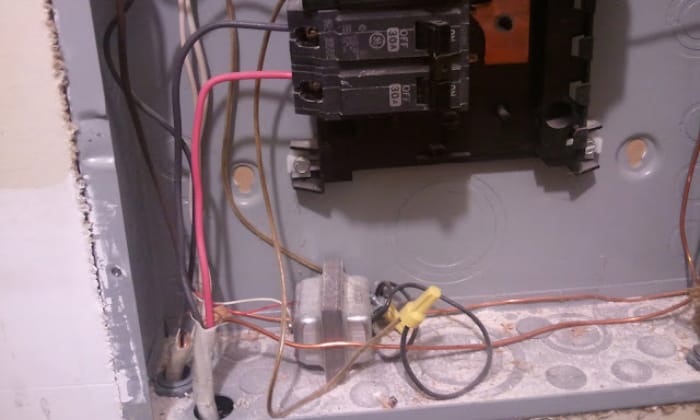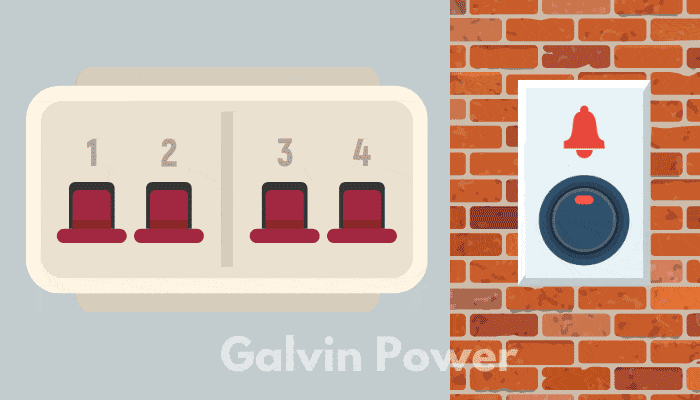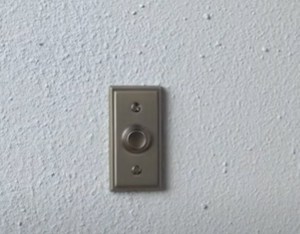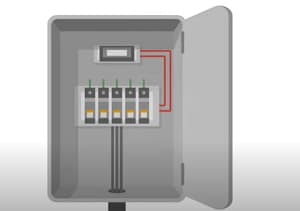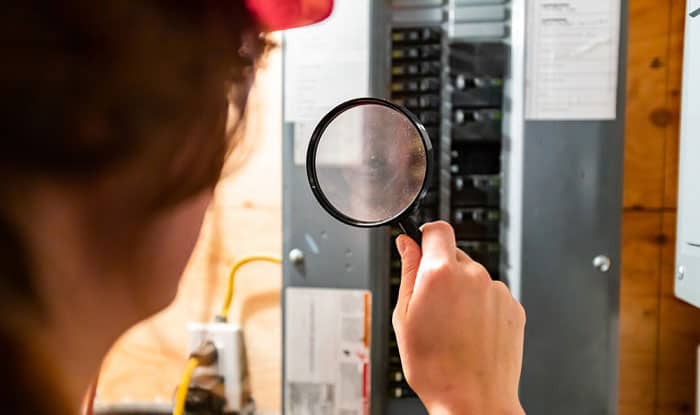Do you plan to change your doorbell or readjust its sound inside your house? Feel free to do so, but first, shut down the circuit breaker connected to your doorbell.
When you ask yourself where is my doorbell breaker, always remember that it doesn’t have a dedicated circuit breaker. Instead, it is wired with other existing receptacles or electrical boxes.
You might not easily find the doorbell breaker inside your main electrical panel. So to trace its power source successfully, you’ll need to learn its wiring system and where it connects.
Table of Contents
Procedures to Find the Breaker
Now that you’ve learned the parts and doorbell mechanics, it’s time to find the circuit breaker that feeds the doorbell’s power supply. A doorbell’s transformer is not directly connected through a dedicated circuit breaker.
Instead, it’s wired to an existing light switch, outlet, or electrical box sharing a circuit with other electrical devices. So, typically, you cannot easily find breaker for the doorbell inside the main electrical panel.
Here are the three steps you can take to solve your searching struggle:
1. Do-it-yourself trial and error
Try to turn off a CB at your breaker panel while subsequently checking if your doorbell still works. Do this with each breaker until you’ve reached the correct one controlling your doorbell. You can perform this effortlessly with another person who will press the buzzer.
- Remember to wear insulated gloves when you touch the surface of your circuit breakers.
On the flip side, this is not a suitable method for households or residential buildings with busy electrical activities such as home offices or garage workshops. So please be responsible when switching each breaker of the house, and NEVER neglect an off breaker if it was previously open.
If you are in a residential area, do not proceed with the operation if you don’t have a building permit.
2. Trace the doorbell’s wire path
This second option in finding doorbell breaker is the best because you’ll need to trace the wirings from the doorbell up to the main breaker panel. Conversely, it is the most challenging to do among the three.
It requires hands-on work, so if you’re not at ease facing this kind of project, hand it over to a professional.
Step 1: Find the chime.
As I’ve previously mentioned, the sound system of a hard-wired doorbell is tough to locate inside the house. Manufacturers usually design a chime to blend well in an area, so to find it, you’ll need to trace the wirings coming from the push-button doorbell outside the house.
However, if your doorbell system is wireless, you can find the chime by hearing where the sound is coming from. The tip here is that contractors customarily install the chime that is audible anywhere in the house. The usual areas are in the kitchen and living/common room.
Step 2: Find the transformer.
The transformer is the heart of the doorbell, for it gives the just right amount of voltage the chime needs. From the chime inside the house, trace its wiring down to the transformer.
The downside of finding the doorbell transformer location is that it’s pretty much concealed somewhere along with the wirings of your home. Just take note that it is always hard-wired near the sound system itself for the most reachable 120 Volts supply, so don’t look too far.
There are two possible ways your doorbell installer did the wiring. First is exposed wires. Find any exposed wires that you can manually trace down to its endpoint, and then there’s your transformer. On the other hand, there’s the second method, where they install it affixed inside the wall.
This type of wiring can go either up to the attic or down your basement. You better look upstairs or downstairs for a nearby electrical box in this situation. Whichever type of wiring your main goal is to find the nearest junction box, receptacle, or switch, where the chime typically shares with the circuit of other devices.
Step 3: Find the circuit breaker.
In this step, you should search the breaker feeding the circuit connected to your transformer. Once you find that specific circuit powering your doorbell, follow its track to its roots residing inside the main electrical panel.
Again, if it’s troublesome to identify the circuit, you can use a tool like an outlet tester or a circuit breaker finder to help you out. Plug it into a receptacle sharing with the same 120V circuit as your doorbell’s transformer.
Lastly, plug a receiver probe into the CBs inside your panel. Do this with each breaker until it indicates the proper breaker matching the receptacle’s circuit.
3. Ask for a professional’s assistance
First is calling a professional contractor or the electrician who installed your doorbell. Besides the fact that this is the most effective way to solve this issue, it is also efficient and less time consumed.
I highly suggest this to those who are not comfortable working in highly electrocuted areas or those who don’t have the skill to tweak wirings when doing a circuit tracing. You won’t have to worry if a professional does all the work because they can fully assist you and relay proper instructions in finding the correct breaker.
On the other hand, if you feel the opposite and don’t mind putting your hands on junction boxes or electrical panels, you might as well do it yourself.
How Do Doorbells Work?
Before you dive into the search for your doorbell circuit breaker, you should know how it works. A doorbell is a simple overall system commonly found in residential homes. However, it’s critical to learn the basics essential for tracing the breaker.
This system works around the concept of electromagnetism. By pressing the doorbell button, its internal electromagnet creates a magnetic field that activates the chime, creating the famous doorbell sound.
A doorbell system comprises three major components: the transformer, chime, and the doorbell itself. First is the transformer, about 16 to 24 volts, depending on how many volts your doorbell needs. Its primary purpose is to step down or lower the voltage coming from a 120-Volt source.
Next is the chime, a component where all the wirings are connected to run the doorbell system as a whole. It’s not usually easy to spot inside the house to match the house’s interior. And last, the doorbell placed at the gate or the front door acts as a push-button to activate the chime.
A doorbell comprises four wirings (usually black and red) connected to the chime. From the transformer, there are two wires, whereas the red wire powers up the chime and the black wire connects to the standard wires.
Meanwhile, two wires are coming from the doorbell (push-button) to the chime. Red goes to the front doorbell, and black goes to the standard wire with the transformer.
Conclusion
There you have it! Tracing the doorbell’s wire path worked best for me when I tried to find ‘where is my doorbell breaker?’ Other methods will work as well, but searching for it manually is the most recommendable one.
Map out the doorbell’s wires by starting with the chime, then the step-down transformer, and finally the breaker. Finding a specific breaker among several circuits is a handful, so don’t expect that you’ll find every component easily. Prepare yourself for the wirings’ complexities.

I am Edwin Jones, in charge of designing content for Galvinpower. I aspire to use my experiences in marketing to create reliable and necessary information to help our readers. It has been fun to work with Andrew and apply his incredible knowledge to our content.

